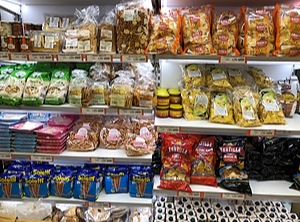AUSTRALIA
Feasibility study for circular economy / Chance of advanced recycling plant in Victoria / Facility could divert nearly a quarter of waste plastics from state landfills
 Food packaging is difficult to recycle mechanically (Photo: PIE) |
Given the country’s national packaging target of using an average of 50% recycled content in packaging by 2025, Australian hydrothermal liquefaction specialist Licella Holdings (Sydney; www.licella.com.au) has conducted a feasibility study to analyse the potential for establishing a local circular economy in the country for “soft plastic” waste – confectionery wrappers, bread bags, etc – with a focus on food packaging and other plastics that are difficult to recycle mechanically. The study found that advanced recycling allows soft plastic waste to be turned back into oil and then made into new food-grade packaging within Australia. “Using the oil created from waste plastic, in the local plastic packaging supply chain, delivers a 64% CO2 reduction compared to crude oil,” Licella said. The company conduced the study with Amcor, Coles, iQ Renew, LyondellBasell, and Nestlé.
Related: Australian government sets out ambitious plans to slash plastics waste
The report based on the findings of the study, entitled “The opportunity for a local circular economy for plastic”, said the Melbourne suburb of Altona is the best-suited location for Australia’s first advanced recycling plant to support the establishment of a local circular economy. If constructed, the facility is expected to create 300 new jobs and contribute about AUD 100m (EUR 63.16m) a year to the economy of the state of Victoria. According to Licella, this facility would use “Cat-HTR” (Catalytic Hydrothermal Reactor) technology, which is a form of hydrothermal liquefaction developed by the company.
Related: UK recycler secures funding for commercial scale Cat-HRT plant
The facility alone is also expected to divert up to 120,000 t, or 24%, of the waste plastics sent to landfill every year in Victoria, where the current annual total of dumped plastics is 500,000 t. If realised, the facility would initially process 20,000 t/y of plastic waste into 17,000 t/y of oil, with the possibility to expand to 120,000 t/y of plastic waste for the production of nearly 100,000 t/y of recycled food-grade plastics.
Related: Australian government sets out ambitious plans to slash plastics waste
The report based on the findings of the study, entitled “The opportunity for a local circular economy for plastic”, said the Melbourne suburb of Altona is the best-suited location for Australia’s first advanced recycling plant to support the establishment of a local circular economy. If constructed, the facility is expected to create 300 new jobs and contribute about AUD 100m (EUR 63.16m) a year to the economy of the state of Victoria. According to Licella, this facility would use “Cat-HTR” (Catalytic Hydrothermal Reactor) technology, which is a form of hydrothermal liquefaction developed by the company.
Related: UK recycler secures funding for commercial scale Cat-HRT plant
The facility alone is also expected to divert up to 120,000 t, or 24%, of the waste plastics sent to landfill every year in Victoria, where the current annual total of dumped plastics is 500,000 t. If realised, the facility would initially process 20,000 t/y of plastic waste into 17,000 t/y of oil, with the possibility to expand to 120,000 t/y of plastic waste for the production of nearly 100,000 t/y of recycled food-grade plastics.
Net zero emissions by 2050
In October this year, right before the 26th UN Climate Change Conference, COP26, Australia announced its commitment to reach net zero emissions by 2050. At the time, Prakash Sharma from Wood Mackenzie said, “The country’s major trading partners – China, Japan, and South Korea – are already in transition towards that goal. Other major energy exporters such as Russia and Saudi Arabia also announced net zero goals by 2060 in recent weeks. This means Australia will need to retool its commodity exports industry to align with the Paris climate targets. This will require Australia to become a significant player in low-carbon hydrogen trade as well as being able to offer carbon storage and offset services.”
The country wants 83% of its power generation to come from solar and wind by 2050, compared to about 20% in 2020. Natural gas, bio energy, geothermal, and small modular reactors are expected to supply the remaining 17% in power output, with coal expected to be phased out by 2035.
The country wants 83% of its power generation to come from solar and wind by 2050, compared to about 20% in 2020. Natural gas, bio energy, geothermal, and small modular reactors are expected to supply the remaining 17% in power output, with coal expected to be phased out by 2035.
20.12.2021 Plasteurope.com [249143-0]
Published on 20.12.2021
